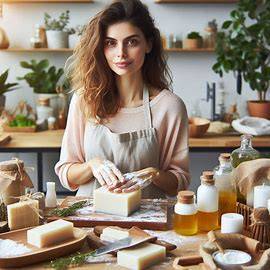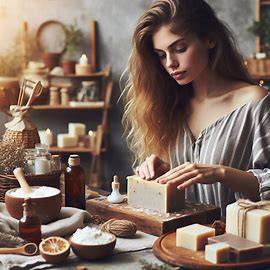-
 DIY: Video master classes
DIY: Video master classes
-
 Aromatherapy
Aromatherapy
-
 Felting master classes
Felting master classes
-
 Eating at home
Eating at home
-
 DIY cosmetics for children
DIY cosmetics for children
-
 Cooking recipes
Cooking recipes
-
 Detergents, cleaning products with your own hands
Detergents, cleaning products with your own hands
-
 Soap making as a business
Soap making as a business
-
 Natural cosmetics. Raw materials for cosmetics and soap.
Natural cosmetics. Raw materials for cosmetics and soap.
-
 Natural oils in cosmetics
Natural oils in cosmetics
-
 News
News
-
 Recipes for balms and conditioners
Recipes for balms and conditioners
-
 Bath Bomb Recipes
Bath Bomb Recipes
-
 Cream recipes. Cream making.
Cream recipes. Cream making.
-
 Lotion recipes. Gel recipes.
Lotion recipes. Gel recipes.
-
 Mask recipes
Mask recipes
-
 Soap recipes. Base soap. Soap from scratch.
Soap recipes. Base soap. Soap from scratch.
-
 Recipes for all occasions
Recipes for all occasions
-
 Natural shampoo recipes
Natural shampoo recipes
-
 Healthy Nutrition Recipes
Healthy Nutrition Recipes
-
 Scrub recipes. Massage tiles. Ubtan
Scrub recipes. Massage tiles. Ubtan
-
 DIY candles
DIY candles
-
 Reference materials, questions, tips
Reference materials, questions, tips
-
 Startup - soap production
Startup - soap production
-
 Hair care. Tips, recipes
Hair care. Tips, recipes
-
 Facial skin care. Cleansers.
Facial skin care. Cleansers.
-
 Body care. Tips, recipes
Body care. Tips, recipes
-
 Photo Reviews
Photo Reviews
-
 Chocolate Handmade
Chocolate Handmade
Natural soap from scratch
 Creating your own natural soap is a rewarding and fulfilling experience that allows you to customize your skincare routine and enjoy the benefits of handmade products. With a little time, patience, and the right ingredients, you can craft beautiful and effective soaps that are gentle on your skin and free from harsh chemicals.
Creating your own natural soap is a rewarding and fulfilling experience that allows you to customize your skincare routine and enjoy the benefits of handmade products. With a little time, patience, and the right ingredients, you can craft beautiful and effective soaps that are gentle on your skin and free from harsh chemicals.
Understanding the Basics of Soap Making
Before diving into the recipes, let's explore the fundamental principles of soap making. The process involves combining oils or fats with a lye solution (sodium hydroxide or potassium hydroxide). When these two substances react, they undergo a chemical process called saponification, which produces soap and glycerin.
Key Ingredients:
- Oils and Fats: The choice of oils and fats will determine the properties of your soap, such as its hardness, lather, and moisturizing qualities. Popular options include olive oil, coconut oil, palm oil, shea butter, and castor oil.
- Lye: This is a strong alkaline substance that reacts with the oils to create soap. Always handle lye with extreme caution and wear protective gear.
- Water: Distilled water is recommended for soap making as it is free from impurities.
Essential Equipment
- Soap mold: Choose a mold that suits your desired shape and size.
- Scale: A precise scale is essential for measuring the oils and lye accurately.
- Thermometer: To monitor the temperature of the oils and lye mixture.
- Blender or immersion blender: For mixing the oils and lye.
- Protective gear: Wear gloves, goggles, and long sleeves when handling lye.
Safety First
- Always wear protective gear: Lye is a strong chemical and can cause severe burns if handled improperly.
- Work in a well-ventilated area: The fumes from lye can be irritating.
- Keep children and pets away: Lye is extremely dangerous if ingested.
Recipe 1: Classic Castile Soap
This is a basic recipe that produces a gentle and versatile soap.
Ingredients:
- 10 ounces olive oil
- 4 ounces coconut oil
- 4 ounces castor oil
- 4 ounces lye
- 12 ounces distilled water
Instructions:
- Prepare the lye solution: Dissolve the lye in the distilled water. Allow the solution to cool to room temperature before using.
- Mix the oils: Combine the olive oil, coconut oil, and castor oil in a heat-resistant container.
- Combine the lye solution and oils: Slowly pour the cooled lye solution into the oil mixture, stirring constantly.
- Trace: Continue stirring until the mixture reaches trace, which means it thickens and starts to hold its shape when you drizzle it from a spoon.
- Pour into mold: Pour the traced mixture into your soap mold.
- Curing: Allow the soap to cure for at least 4-6 weeks before using. This process allows the soap to harden and mature.
Recipe 2: Lavender and Honey Soap
This recipe creates a luxurious and fragrant soap with soothing properties.
Ingredients:
- 8 ounces olive oil
- 4 ounces coconut oil
- 2 ounces shea butter
- 4 ounces lye
- 12 ounces distilled water
- 1/4 cup dried lavender
- 1 tablespoon honey
Instructions:
Follow the same instructions as for the classic Castile soap recipe. Add the dried lavender and honey to the traced mixture before pouring it into the mold.
 Recipe 3: Oatmeal and Tea Tree Oil Soap
Recipe 3: Oatmeal and Tea Tree Oil Soap
This recipe is ideal for those with sensitive or acne-prone skin.
Ingredients:
- 8 ounces olive oil
- 4 ounces coconut oil
- 2 ounces castor oil
- 4 ounces lye
- 12 ounces distilled water
- 1/4 cup ground oatmeal
- 10 drops tea tree oil
Instructions:
Follow the same instructions as for the classic Castile soap recipe. Add the ground oatmeal and tea tree oil to the traced mixture before pouring it into the mold.
Tips for Successful Soap Making:
- Weigh your ingredients accurately: Even a slight discrepancy in measurements can affect the outcome of your soap.
- Be patient: The curing process is essential for the soap to mature and develop its properties.
- Experiment with different oils and additives: Try different combinations of oils and add-ins to create unique and customized soaps.
- Store your soap properly: Keep your soap in a cool, dry place to prevent it from becoming rancid.
With a little practice and experimentation, you can create beautiful and functional natural soaps that are perfect for your skincare routine or as thoughtful gifts for loved ones.
";s:4:"TYPE";s:4:"HTML";}Mylo Opt Cosmetics Blog – Your Reliable Guide to Beauty and Care
Welcome to the Mylo Opt cosmetics blog! Here, you will find valuable advice, interesting recipes, and professional recommendations for creating soap, cosmetics, and candles with your own hands. Our blog is designed for anyone passionate about natural cosmetics, looking for new ideas, and wanting to learn more about producing high-quality skincare and haircare products. We share tested recipes, useful tips, and the latest news from the world of cosmetics.
Why Choose the Mylo Opt Cosmetics Blog?
Mylo Opt is not just an online store; it is a community of people passionate about creating natural cosmetics. Here are a few reasons why our blog will be useful to you:
- Experience and Expertise: Our authors are experienced cosmetologists, soap makers, and aromatherapy specialists. We share reliable and tested recipes that have undergone thorough testing and received positive feedback.
- Credibility and Authority: We ensure that all information in our blog is up-to-date and reliable. We reference scientific research and verified sources so that you can trust the quality of the information provided.
- Reader-Focused: Our content is tailored to you – our readers. We strive to answer your questions, solve your problems, and inspire new achievements in the world of natural cosmetics.
Popular Products from the Mylo Opt Online Store
Before we move on to recipes and tips, let us introduce you to the most popular products from our online store, which will help you create high-quality and natural cosmetics:
- Soap Bases: High-quality soap bases allow you to create beautiful and beneficial handmade soaps. We offer glycerin bases, bases with added oils and extracts, as well as transparent and white bases.
- Fragrance Oils and Fragrances: Give your products a unique scent with our fragrance oils and fragrances. We offer a wide range of scents – from fresh and floral to spicy and woody.
- Essential Oils: Essential oils are natural components that not only add fragrance to products but also offer beneficial properties for the skin and hair. Our range includes lavender, mint, eucalyptus, lemon, and many other oils.
- Active Ingredients: Vitamins, antioxidants, hyaluronic acid, and other active ingredients help improve the properties of your cosmetics. We offer only tested and high-quality components.
- Pigments and Dyes: Give your products bright and lasting colors with our pigments and dyes. They are safe for the skin and suitable for use in soap, cosmetics, and candles.
- Emulsifiers and Thickeners: To create creams and lotions, you will need emulsifiers and thickeners. We offer quality ingredients that help you achieve the desired consistency and stability of the product.
- Soap and Candle Molds: Create unique items with our soap and candle molds. Our range includes molds of various sizes and designs.
- Everything for Candles: Wax, wicks, fragrances, and dyes for candles – we have everything you need to create beautiful and fragrant candles.
Recipes and Tips for Making Handmade Soap
Cold Process Soap for Beginners
Making cold process soap is an exciting process that allows you to control all the ingredients and create unique recipes. Here is one simple cold process soap recipe for beginners:
Ingredients:
- 500 g olive oil
- 300 g coconut oil
- 200 g palm oil
- 150 g castor oil
- 120 g lye (sodium hydroxide)
- 300 ml distilled water
- Essential oils (lavender, mint, eucalyptus)
- Pigments or natural dyes (optional)
Process:
- Prepare all ingredients and tools. Always use protective gloves and goggles, as lye can be dangerous.
- Weigh the lye and water. Slowly add the lye to the water, stirring until it fully dissolves. Allow the mixture to cool to 40-45°C.
- Weigh the oils and melt them in a water bath. When the oils and lye solution reach the same temperature (about 40-45°C), slowly pour the lye into the oils, stirring constantly.
- Use an immersion blender to mix until trace (when the mixture thickens and leaves a trail when stirred).
- Add essential oils and pigments if desired. Mix thoroughly.
- Pour the mixture into a prepared mold and cover with a towel. Let the soap harden for 24-48 hours.
- Remove the soap from the mold and cut it into bars. Allow the soap to cure for 4-6 weeks before use.
Homemade Cosmetics Recipes
DIY Moisturizing Cream
Creating a moisturizing cream at home allows you to control the ingredients and adapt the recipe to your needs. Here is a simple recipe for a moisturizing cream:
Ingredients:
- 50 ml rose water
- 50 ml distilled water
- 10 g emulsifier (e.g., Olivem 1000)
- 10 ml jojoba oil
- 5 ml avocado oil
- 5 drops lavender essential oil
- 2 drops tea tree essential oil
Process:
- Weigh all the ingredients.
- In a water bath, melt the emulsifier with the oils until smooth.
- Separately, heat the water phase (rose water and distilled water) to the same temperature as the oil phase.
- Slowly pour the water phase into the oil phase, stirring constantly.
- Use an immersion blender to emulsify until you achieve a creamy consistency.
- Add essential oils and mix thoroughly.
- Pour the cream into a sterilized jar and allow it to cool.
DIY Candle Recipes
Aromatic Soy Candle
Creating aromatic candles is a creative process that allows you to experiment with scents and designs. Here is a simple recipe for a soy candle:
Ingredients:
- 200 g soy wax
- 20 ml fragrance oil (e.g., vanilla or lavender)
- Wick for candles
- Dyes (optional)
- Glass or metal candle mold
Process:
- Melt the soy wax in a water bath until liquid.
- Add the fragrance oil and dyes if desired. Mix thoroughly.
- Secure the wick in the center of the candle mold.
- Slowly pour the melted wax into the mold, holding the wick.
- Allow the candle to fully harden (about 24 hours).
- Trim the wick to the desired length and enjoy your aromatic candle.
Tips for Beginners in Cream Making
- Learn the Basics: Before starting to create creams, it is important to learn the basic principles and ingredients used in cream making.
- Experiment with Formulas: Do not be afraid to experiment with different ingredients and proportions to find the perfect formula for your skin.
- Use Quality Ingredients: The effectiveness and safety of your product depend on the quality of the ingredients. Always choose tested and natural components.
- Maintain Hygiene: It is important to maintain cleanliness and sterility when creating cosmetics to avoid contamination and spoilage of the product.
- Start with Simple Recipes: For beginners, it is best to start with simple recipes to master the basic techniques and principles of cream making.
Conclusion
Our Mylo Opt cosmetics blog is your reliable source of information and inspiration in the world of natural cosmetics. We share useful tips, tested recipes, and the latest news to help you create quality and effective products for skin, hair, and home care. Subscribe to our blog, follow the updates, and discover new opportunities in the world of natural cosmetics with Mylo Opt!





